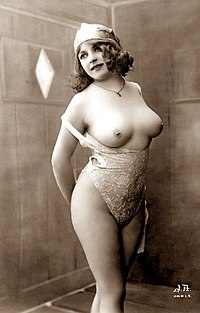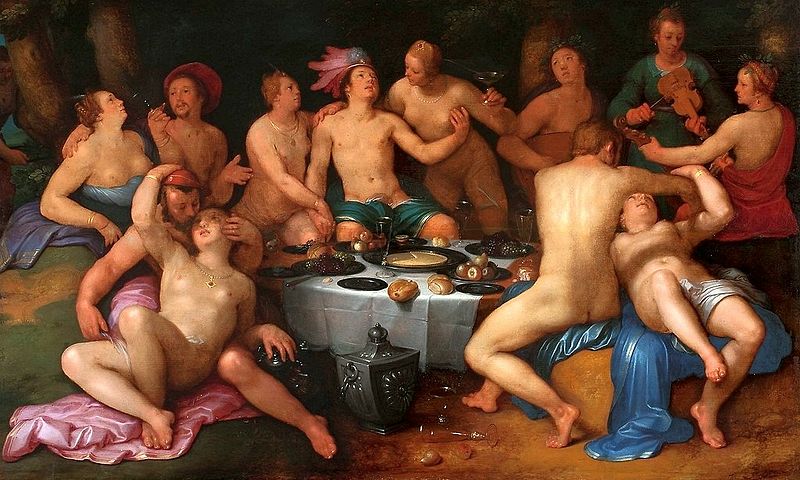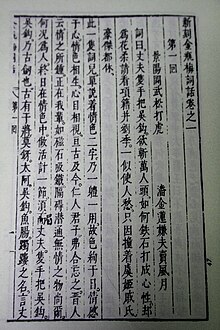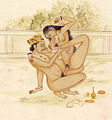Portal:Erotica and pornography
Introduction

Pornography (colloquially known as porn or porno) has been defined as sexual subject material "such as a picture, video, or text" that is intended for sexual arousal. Made for the consumption by adults, pornography depictions have evolved from cave paintings, some forty millennia ago, to virtual reality presentations. A general distinction of adult content is made classifying it as pornography or erotica.
The oldest artifacts considered pornographic were discovered in Germany in 2008 CE and are dated to be at least 35,000 years old. Throughout the history of erotic depictions, various people made attempts to suppress them under obscenity laws, censor, or make them illegal. Such grounds and even the definition of pornography have differed in various historical, cultural, and national contexts. The Indian Sanskrit text Kama Sutra (3rd century CE) contained prose, poetry, and illustrations regarding sexual behavior, and the book was celebrated; while the British English text Fanny Hill (1748), considered "the first original English prose pornography," has been one of the most prosecuted and banned books. In the late 19th century, a film by Thomas Edison that depicted a kiss was denounced as obscene in the United States, whereas Eugène Pirou's 1896 film Bedtime for the Bride was received very favorably in France. Starting from the mid-twentieth century on, societal attitudes towards sexuality became more lenient in the Western world where legal definitions of obscenity were made limited. In 1969, Blue Movie became the first film to depict unsimulated sex that received a wide theatrical release in the United States. This was followed by the "Golden Age of Porn" (1969–1984). The introduction of home video and the World Wide Web in the late 20th century led to global growth in the pornography business. Beginning in the 21st century, greater access to the Internet and affordable smartphones made pornography more mainstream. (Full article...)
Erotica is literature or art that deals substantively with subject matter that is erotic, sexually stimulating or sexually arousing. Some critics regard pornography as a type of erotica, but many consider it to be different. Erotic art may use any artistic form to depict erotic content, including painting, sculpture, drama, film or music. Erotic literature and erotic photography have become genres in their own right. Erotica also exists in a number of subgenres including gay, lesbian, women's, bondage, monster and tentacle erotica.
The term erotica is derived from the feminine form of the ancient Greek adjective: ἐρωτικός (erōtikós), from ἔρως (érōs)—words used to indicate lust, and sexual love. (Full article...)
Selected article
A pornographic film actor or actress, pornographic performer, adult entertainer, or porn star is a person who performs sex acts on video that is usually characterized as a pornographic movie. Such videos tend to be made in a number of distinct pornographic subgenres and attempt to present a sexual fantasy; the actors selected for a particular role are primarily selected on their ability to create or fit that fantasy. Pornographic videos are characterized as either softcore, which does not contain depictions of sexual penetration or extreme fetishism, and hardcore, which can contain depictions of penetration or extreme fetishism, or both. The genres and sexual intensity of videos is mainly determined by demand. Depending on the genre of the film, the on-screen appearance, age, and physical features of the actors and their ability to create the sexual mood of the video is of critical importance. Most actors specialize in certain genres, such as straight, bisexual, gay, lesbian, bondage, strap-on, anal, double penetration, semen swallowing, teenage, orgy, age roleplay, fauxcest, interracial or MILFs and more.
The pornography industry in the United States was the first to develop its own movie star system, primarily for commercial reasons. In other countries, the "star" system is not common, with most actors being amateurs. Most performers use a pseudonym and strive to maintain off-screen anonymity. A number of pornographic actors and actresses have written autobiographies. It is very rare for pornographic actors and actresses to successfully cross over to the mainstream film industry. Certain pornographic actors have leveraged their success to branch into different entrepreneurial endeavours, such as Jenna Jameson's ClubJenna.
Leaked patient database of Adult Industry Medical Health Care Foundation in 2011 contained details of over 12,000 pornographic actors that it had tested since 1998, providing estimates of the number of pornographic film actors who have worked in the United States. , it was reported that roughly 1,200–1,500 performers were working in California's "Porn Valley".[needs update] (Full article...)Selected work of erotic literature
Jin Ping Mei (Chinese: 金瓶梅)—translated into English as The Plum in the Golden Vase or The Golden Lotus—is a Chinese novel of manners composed in vernacular Chinese during the latter half of the 16th century during the late Ming dynasty (1368–1644). Consisting of 100 chapters, it was published under the pseudonym Lanling Xiaoxiao Sheng (蘭陵笑笑生), "The Scoffing Scholar of Lanling," but the only clue to the actual identity is that the author hailed from Lanling County in present-day Shandong. The novel circulated in manuscript as early as 1596, and may have undergone revision up to its first printed edition in 1610. The most widely read recension, edited and published with commentaries by Zhang Zhupo in 1695, deleted or rewrote passages to help understand the author's intentions.
The explicit depiction of sexuality garnered the novel a notoriety akin to Lady Chatterley's Lover and Lolita in the West, but critics such as the translator David Tod Roy see a firm moral structure which exacts retribution for the sexual libertinism of the central characters.
Jin Ping Mei takes its name from the three central female characters—Pan Jinlian (潘金蓮, whose given name means "Golden Lotus"); Li Ping'er (李瓶兒, literally "Little Vase"), a concubine of Ximen Qing; and Pang Chunmei (龐春梅, "Spring plum blossoms"), a young maid who rose to power within the family. Chinese critics see each of the three Chinese characters in the title as symbolizing an aspect of human nature, such as mei (梅), plum blossoms, being metaphoric for sexuality. (Full article...)List of selected works
|
|---|
Slideshow of selected contemporary images
Slideshow of selected historical images
Did you know (auto-generated) -

- ... that Aroha Bridge changed its name from Hook Ups because fans searching for the show often found pornography instead?
- ... that in 2001, around 64 percent of all films produced in Malayalam were of the soft-porn variety?
- ... that the 1983 pink film Beautiful Mystery was one of the earliest commercially produced gay pornographic films in Japan?
- ... that Lewes Road in Brighton has a gyratory named after a pornographic cinema?
- ... that Christian radio station KIXL near Austin, Texas, pulled an anti-pornography program off-air in mid-transmission because of its graphic descriptions of gay sex?
- ... that according to one source, The Embroidered Couch is "most likely China's earliest vernacular pornographic novel"?
- ... that a pornographic video service once offered NFL quarterback Gardner Minshew a one-million-dollar endorsement deal based on his habit of exercising in nothing but a jockstrap?
- ... that the 1980s were the "age of hole-discovery" in yaoi erotica?
Topics
Categories
Related portals
Associated WikiProjects
 |
 |
| Sexology and sexuality | Pornography |
Associated Wikimedia
The following Wikimedia Foundation sister projects provide more on this subject:
-
Commons
Free media repository -
Wikibooks
Free textbooks and manuals -
Wikidata
Free knowledge base -
Wikinews
Free-content news -
Wikiquote
Collection of quotations -
Wikisource
Free-content library -
Wikiversity
Free learning tools -
Wiktionary
Dictionary and thesaurus





































































![Image 16Indian Princess, by Richard Borrmeister [de] (1888?)](http://upload.wikimedia.org/wikipedia/commons/thumb/0/01/Richard_Borrmeister_Indische_Prinzessin_1888.jpg/102px-Richard_Borrmeister_Indische_Prinzessin_1888.jpg)




































